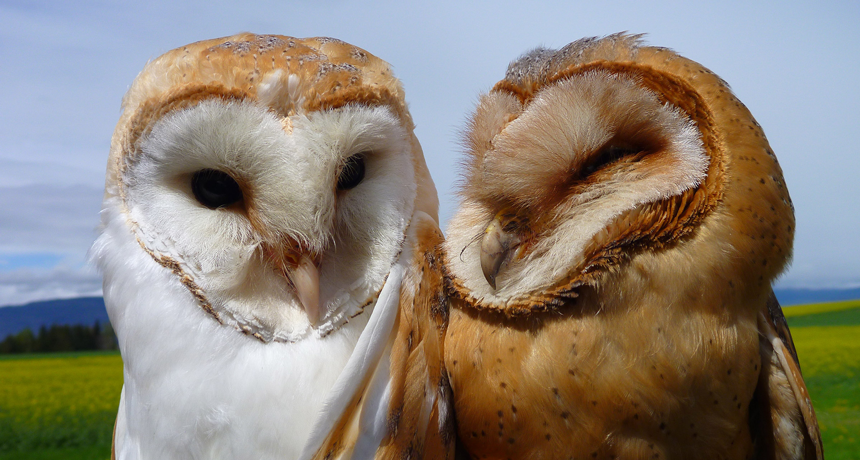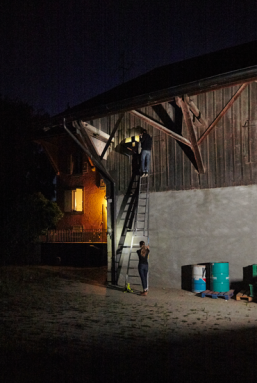Standing out helps barn owls on the hunt
White feathers reflect moonlight, stunning their prey

Barn owls can be quite white, quite red — or somewhere in between.
Isabelle Henri
Owls are silent hunters. Their soft-edged feathers hardly make a sound as the birds fly through the night in search of a meal. Given that stealth, it would make sense that owls are also well camouflaged. It’s no good to sneak up on your dinner only to have it make a quick escape because it saw you coming. But for barn owls, blending in isn’t always the advantage you might think. Having lighter feathers actually helps white owls hunt, a new study finds.
Barn owls can be found all over the world. These crow-sized birds have reddish-brown wings with patches of gray. But their faces, bellies and the undersides of their wings range from all white to all red. That’s true for both males and females. These silent hunters search out voles, mice and shrews, mainly at dusk and dawn. But when they have owlets to feed, they’ll hunt all night long to get enough food for everyone in the family.
Red and white barn owls sometimes catch different amounts of prey. Luis M. San-José works at the University of Lausanne in Switzerland. As an evolutionary ecologist, he studies how species have adapted to their environments. And he wondered if an owl’s coloring had anything to do with its ability to nab dinner.

To find out, he teamed up with Alexandre Roulin, another evolutionary ecologist at the University of Lausanne. Roulin had been studying barn owls in western Switzerland since 1991. He has hundreds of nest boxes on farms in the area. Those owls use the nest boxes. That makes it easy for the scientists to find their nests, catch the birds and study their behaviors.
San-José and Roulin set up night-vision video cameras or camera traps outside 131 of the nest boxes. The pair then recorded activity for three or four nights at each nest box. By studying the video and camera images, they could tally the prey that each owl caught.
The scientists also caught each bird and measured the color of its feathers. They did this using a color key. It rated the hue of the birds’ feathers from very red to very white. Lastly, they recorded the phase of the moon on each night of hunting. San-José says they figured the owls might be well concealed during new moon nights, when the sky is dark. During the brightness of a full moon, they expected white owls would stand out more. That might mean they’d catch fewer rodents than dark-red owls.
All of the owls hunted well during a new moon. The darkness did, in fact, make it easier for these birds to sneak up on their prey. During a full moon, it was the red owls that struggled to catch dinner. White owls had no problem — even though their white feathers reflected the light of a full moon. Further study showed that their extra meals might have had a real benefit: Those white barn owls raised more young than red owls did.
Frozen with fear?
San-José and Roulin were surprised by their findings. Why were white owls so good at hunting, even when they shone like a beacon in the moonlight? Perhaps, they thought, it had something to do with the behavior of their prey. To explore, they set up an experiment with voles. These short-tailed, mouse-size rodents make up more than half of a barn owl’s diet.
The team set up a room with three long sections separated by black cloth. At one end, San-José would place a vole. Hidden at the other end of the room were two taxidermied (stuffed) owls. One was red, the other white. Each had been prepared with its wings out, so they appeared to be flying.
The team uncovered one stuffed owl and then ran it down a zip line. This was to mimic it flying. It also brought the owl straight toward the vole, as if it were about to strike. One hour later, the vole was tested again, this time with the owl of the other color. Tests were run once while the light was low, as if it were a new moon, and again in bright light to mimic a full moon.
Most voles didn’t react differently to red or white owls when the light was low. But in bright light, they easily spotted the red owls coming and hid. More unexpectedly, when approached by a brightly-lit white owl, the voles froze. This is similar to when a deer freezes in front of a car’s headlights. In the wild, this would have given the white owls plenty of time to snatch up some dinner.
In a final experiment, the team coated the feathers of one of the white taxidermied owls with wax. That cut down how much light the feathers reflected. The researchers then ran their tests using the wax-coated owl and an untreated white owl. Voles didn’t freeze when the wax-coated owl swooped across the room. This confirmed that it was light reflecting off the white feathers that “stunned” the rodents.
The findings appeared September 2 in Nature Ecology & Evolution.
“This is one of the first studies to show to us how little we know about living in the dark,” says Robert Zink. He is an bird biologist at the University of Nebraska–Lincoln who was not involved with the study. Diurnal creatures are active most often during the day. “We humans are diurnal creatures for the most part,” he points out. And as such, he says, that makes “it hard for us to understand how nocturnal animals make a living.”
San-José doesn’t know why voles respond to white owls the way they do. But he plans to find out in future studies. “Nocturnal life is far more colorful than we see with our limited vision,” he says. “Many discoveries are awaiting us out there in the dark.”







